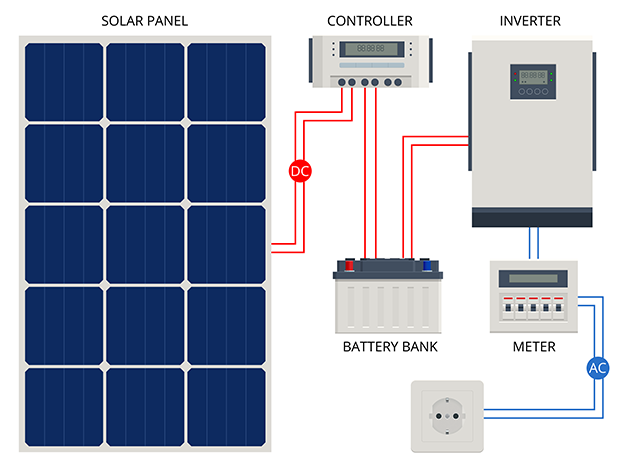Solar Panel Products Overview
A complete home solar panel energy system requires several components to collect, convert, store and provide a continuous source of energy. The basic components include the panels, mounts, inverter, battery, monitoring system and the standard electrical components including the Breaker Panel, AC Panel, and Circuit Breaker Panel.
Solar Panels
Solar panels are the most noticeable component of a residential solar electric system. The solar panels are installed outside the home, typically on the roof and convert sunlight into electricity.
Photovoltaics describe the process of converting sunlight into electricity. This process gives solar panels their alternate name, PV panels.
Solar panels are given output ratings in watts. This rating is the maximum produced by the panel under ideal condition. EcoMark high performance panels can produce from 360 – 400 watts, well above the average output.
Click here to See our solar panel options
Mounting Racks
Solar panels are mounted on roofs, and we also offer ground arrays. Roof mounted systems are the most common and may be required by zoning ordinances. This approach is aesthetic and efficient.
Critter Guard and Snow Guard
Critter guards protect the area underneath your solar panels from nest birds and other critters. In Colorado they are a must-have. They will prevent potentially larger damage to your roof and EcoMark Solar recommends the with every install. Snow Guards protect against snow building up under your panels where damage can occur. EcoMark will make a recommendation on snow guards for each install.
Array DC Disconnect
The Array DC disconnect is used to disconnect the solar arrays from the home for maintenance. It is called a DC disconnect because the solar arrays produce DC (direct current) power.
Inverter
Solar panels and batteries produce DC (direct current) power. Standard home appliances use AC (alternating current). An inverter converts the DC power produced by the solar panels and batteries to the AC power required by appliances.
Click here is see our Energy Hub Inverter
Monitoring System
A software monitoring system will provide real time information about the health and efficiency of your system as well as information about your energy use.
Click here to see our SolarEdge Monitoring System
Battery Pack
Solar power systems produce electricity during the daytime, when the sun is shining. Your home demands electricity at night and on cloudy days – when the sun isn’t shining as well. Battery storage will ensure you have power even when the sun is not shining.
Click Here to see out
Power Meter, Utility Meter, Kilowatt Meter
For systems that maintain a tie to the utility grid, the power meter measures the amount of power used from the grid. In systems designed to sell power the utility, the power meter also measures the amount of power the solar system sends to the grid.
Breaker Panel, AC Panel, Circuit Breaker Panel
The breaker panel is where the power source is joined to the electrical circuits in your home. A circuit is a continuous route of connected wire that joins together outlets and lights in the electric system.

